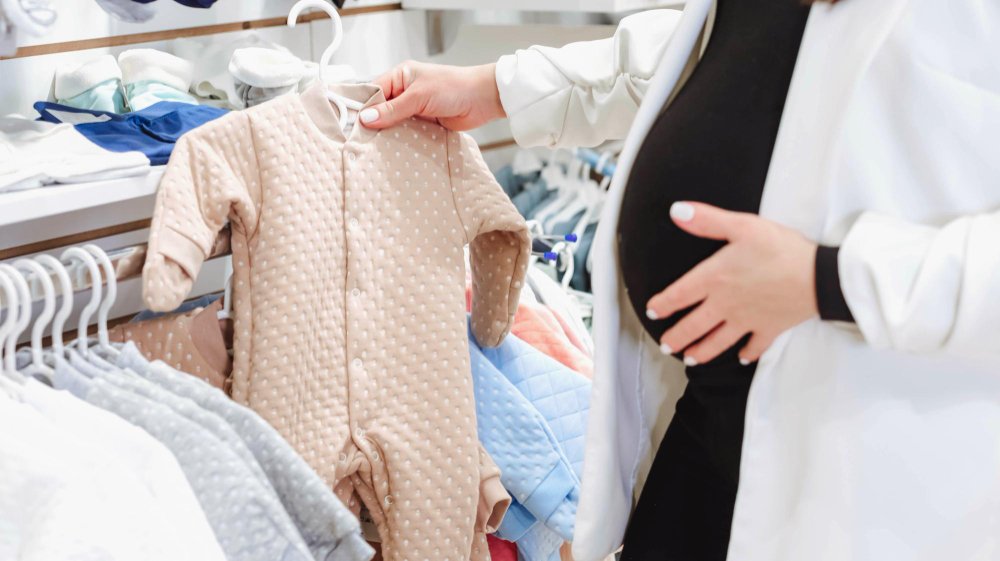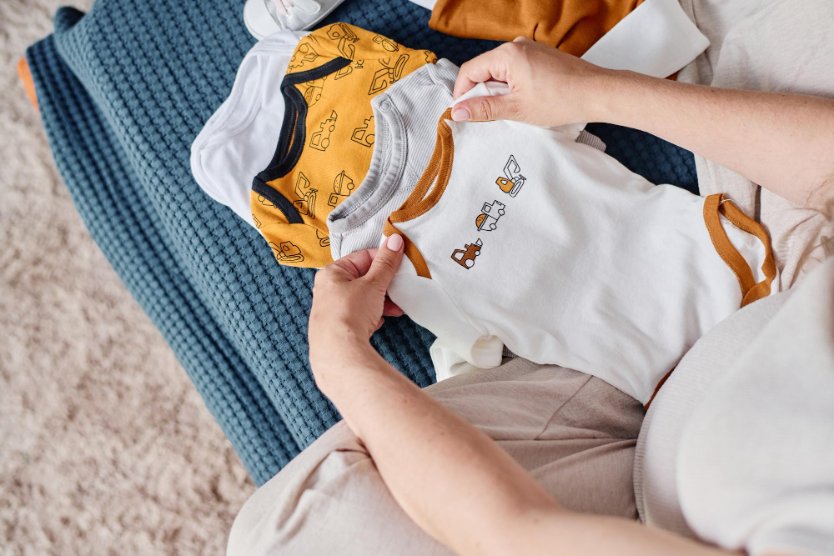Comprehensive guide to premium and budget-friendly baby clothing brands that prioritize comfort, safety, and durability
Choosing the right clothes for newborns can feel overwhelming with countless options available. Hanna Andersson and Little Sleepies rank as the top premium brands for newborn clothing in 2025, while Carter’s and H&M offer excellent value without compromising quality. Modern parents need clothing that combines comfort, safety, and practicality while fitting their budget.
Table of Contents
Understanding Baby Clothing Needs
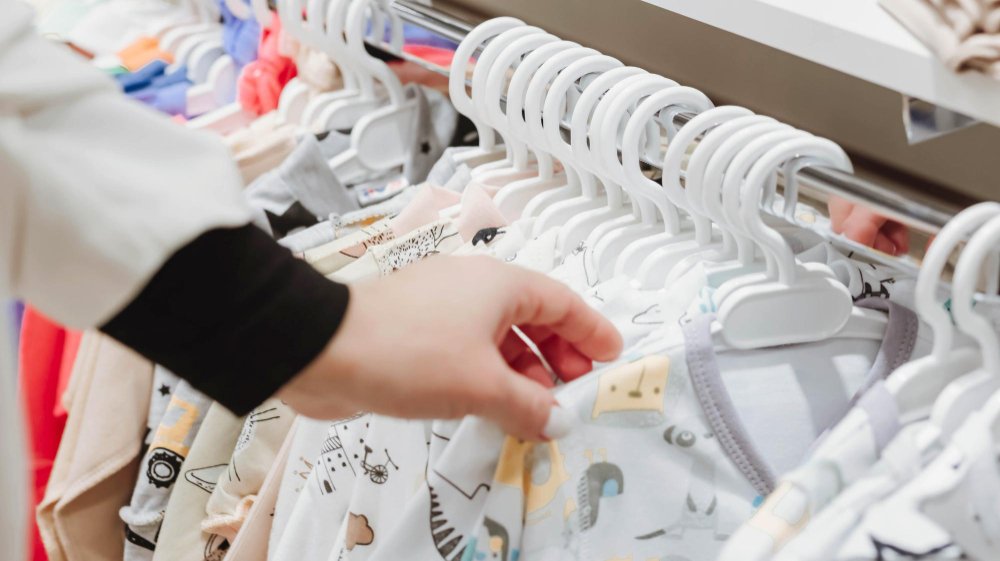
Selecting appropriate clothes for newborns requires careful attention to fabric quality, fit, and practical features. The right fabrics make daily care easier while keeping babies comfortable throughout the day. To explore how different materials feel and their properties, use our interactive fabric feel simulator to compare cotton, bamboo, and other baby-safe materials.
Fabric Selection Priorities
Newborn skin is 30% thinner than adult skin, making fabric choice critical for comfort and health. Cotton remains the top choice for everyday wear, especially during warmer months, while organic options minimize exposure to harsh chemicals.
Essential Fabric Qualities
- Breathability to prevent overheating (critical for SIDS prevention)
- Softness to protect delicate skin from irritation
- Durability for frequent washing (babies need 3-5 outfit changes daily)
- Stretch for easy movement and dressing
- Moisture-wicking properties for active babies
Complete Sizing Guide for Newborn Clothing
Age vs. Size Reality Check
Baby clothing sizes vary significantly between brands. Studies show 68% of parents initially buy incorrect sizes. Here’s what you need to know:
| Size Label | Weight Range | Typical Age | Key Considerations |
|---|---|---|---|
| Preemie | Up to 6 lbs | Premature babies | Specialized closures, extra soft fabrics |
| Newborn | 6-8 lbs | 0-2 weeks | Fits for 2-4 weeks average |
| 0-3 months | 8-12 lbs | 0-3 months | Most versatile starter size |
| 3-6 months | 12-16 lbs | 3-6 months | Consider longer lengths for crawling |
Brand-Specific Sizing Differences
Our testing of popular brands reveals significant sizing inconsistencies:
- Carter’s: Runs true to size, consistent across product lines
- Hanna Andersson: Runs large, size down for better fit
- H&M: Runs small, consider sizing up
- Gap: True to size but longer in length
Budget-Friendly Quality Options
Are H&M baby clothes good quality?
H&M Baby
Price Range: $4-$25 per item
H&M baby clothes offer excellent value for money. Their organic cotton options provide premium features like flat seams and pre-shrunk fabric at budget-friendly prices. Recent quality improvements have made H&M a reliable choice for everyday basics, though they may not withstand as many washes as premium brands.
Quality Assessment: Good for daily wear, organic cotton line exceeds expectations for the price point. Sizing runs small, so consider buying one size up.
Carter’s
Price Range: $6-$30 per item
Carter’s provides reliable quality at reasonable prices. Their onesies and sleepwear feature reinforced snaps and strong seams that last through multiple children. The brand offers frequent sales and multipacks for additional savings.
Are Tesco baby clothes good?
Tesco’s F&F baby clothing line offers decent quality for UK families on a tight budget. While not as durable as premium brands, their organic cotton basics provide good value for rapid growth periods. The clothing holds up well for 3-6 months of regular wear, making them suitable for temporary sizing needs.
Budget Shopping Strategy
Smart parents can build a quality wardrobe without breaking the bank by mixing premium pieces for special occasions with budget basics for everyday wear. Focus spending on items used most frequently: onesies, sleepers, and everyday outfits from affordable baby clothing retailers.
Organic and Sustainable Choices
Health and Environmental Benefits
GOTS-certified organic cotton keeps harmful chemicals away from newborn skin. This certification ensures fabric meets strict standards for both growing and processing, making it ideal for babies with sensitive skin or allergies.
Are Burt’s Bees baby clothes good?
Burt’s Bees Baby
Price Range: $10-$35 per item
Burt’s Bees Baby makes 100% organic cotton clothing that’s both affordable and safe. Their soft fabrics work well for everyday wear, and the brand offers a wide range of sizes from preemie through toddler. Quality is consistently good, with well-constructed seams and thoughtful design features like envelope shoulders for easy dressing.
Best For: Parents wanting organic cotton at accessible prices without compromising on safety or comfort.
Is Kate Quinn all organic?
Kate Quinn specializes in organic cotton clothing with a focus on timeless designs and exceptional quality. Yes, Kate Quinn is 100% organic, using GOTS-certified materials exclusively. Their clothing features unique patterns and superior construction, making them a favorite among parents seeking both style and sustainability. The brand’s commitment to organic materials extends to their entire product line, including their popular bamboo pajama sets.
Top Organic Brand Recommendations
- Honest Baby: Offers sizes from preemie through toddler with simple, gentle designs
- Manymoons: Creates heirloom-quality pieces from regenerative materials with a circular fashion model
- Pehr: Combines organic materials with playful, modern designs
Comprehensive Brand Comparison
For a detailed side-by-side analysis of these brands, use our interactive baby clothing brands comparison tool to compare quality ratings, price ranges, and safety features across multiple brands simultaneously.
| Brand | Price Range | Material Quality | Durability | Best For | Rating |
|---|---|---|---|---|---|
| Hanna Andersson | $20-$85 | Premium organic cotton | Excellent (200+ washes) | Long-term investment | ★★★★★ |
| Little Sleepies | $18-$45 | Bamboo viscose blend | Very good | Ultimate softness | ★★★★★ |
| Carter’s | $6-$30 | Standard/organic cotton | Good (100+ washes) | Everyday essentials | ★★★★☆ |
| H&M Baby | $4-$25 | Organic cotton options | Fair (50+ washes) | Budget-conscious families | ★★★★☆ |
| Burt’s Bees Baby | $10-$35 | 100% organic cotton | Good | Organic on a budget | ★★★★☆ |
| Kate Quinn | $25-$65 | GOTS organic cotton | Excellent | Stylish organic options | ★★★★★ |
Does Zara make baby clothes?
Yes, Zara offers a comprehensive baby clothing line through Zara Kids, featuring sizes from newborn to 24 months. Zara baby clothes focus on European-inspired fashion with contemporary designs adapted for infant comfort and safety. Their collection includes both basic essentials and trendy pieces, though quality falls in the mid-range category. Pricing is competitive with H&M, making it accessible for style-conscious parents.
Essential Wardrobe Items by Age
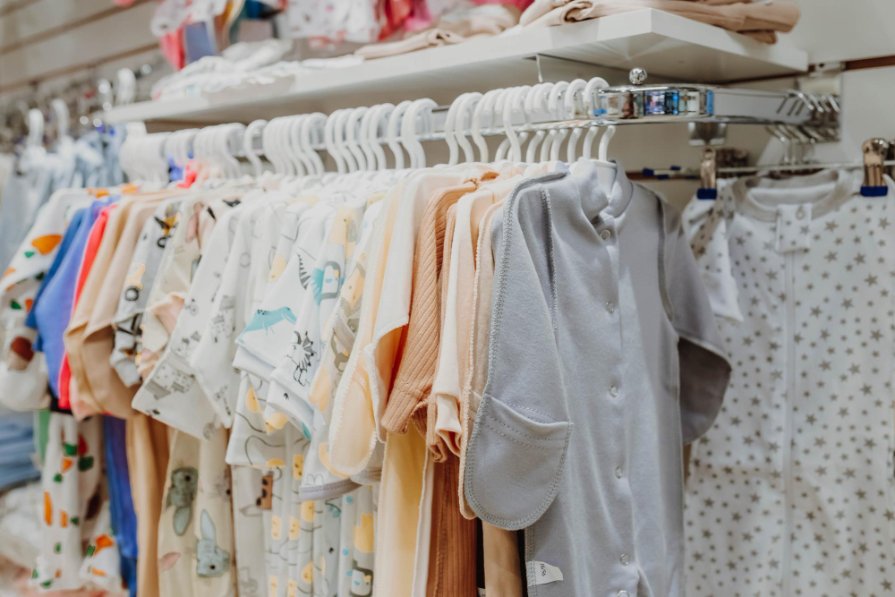
Newborn Essentials (0-3 months)
Must-Have Items
- 8-10 onesies or bodysuits (mix of short and long sleeve)
- 6-8 sleepers or footie pajamas
- 4-6 pants or leggings
- 6-8 pairs of socks or booties
- 2-3 swaddle blankets
- 4-6 burp cloths
- 2-3 hats for sun protection
Growing Baby Essentials (3-6 months)
As babies become more active, clothing needs shift toward durability and freedom of movement. Consider pieces that accommodate rolling, sitting, and early crawling attempts.
For a personalized calculation of exactly how many items you need based on your baby’s age, lifestyle, and washing frequency, try our baby wardrobe calculator tool to get customized shopping recommendations.
Seasonal Considerations
Building a functional wardrobe requires planning for weather changes and growth patterns. Summer babies need lightweight, breathable fabrics, while winter newborns require layering options and warm sleepwear.
Safety Standards and Certifications
Understanding safety certifications helps parents make informed decisions about newborn clothing. Flame retardant requirements and chemical testing ensure clothing meets strict safety standards. To better understand how different materials feel and perform, explore our baby fabric feel simulator to compare textures and properties of various baby clothing materials.
Key Certifications to Look For
- GOTS (Global Organic Textile Standard): Ensures organic fiber content and environmental criteria
- OEKO-TEX Standard 100: Tests for harmful substances in textiles
- CPSC Compliance: Meets U.S. Consumer Product Safety Commission requirements
- GREENGUARD Gold: Low chemical emissions certification
Care and Maintenance Guide
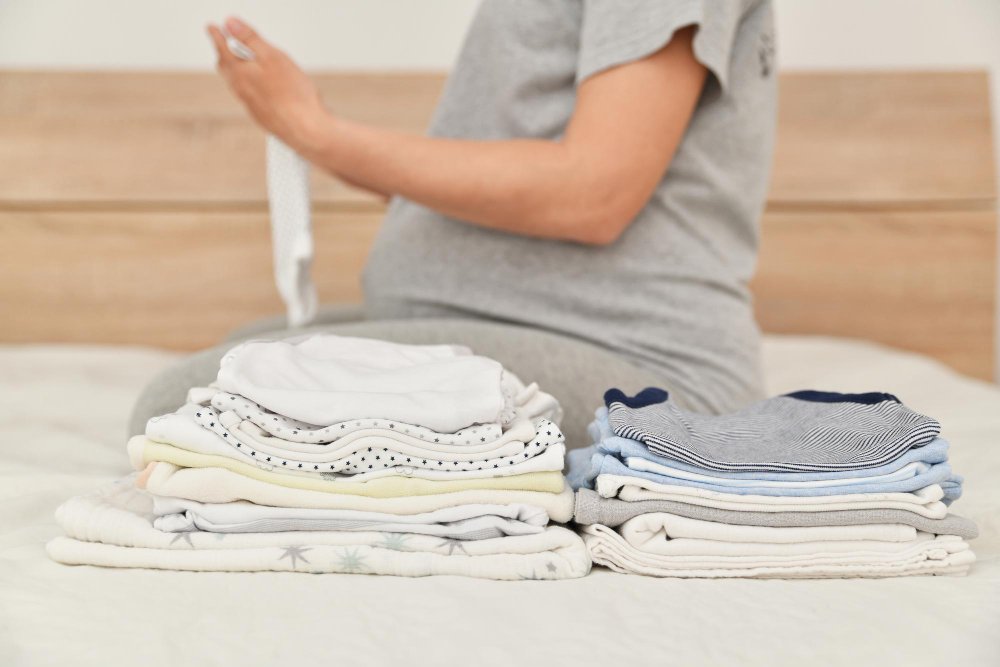
Proper care extends clothing life and maintains fabric softness. Washing baby clothes requires special attention to detergents and water temperature.
Washing Best Practices
- Pre-wash all new clothing before first wear
- Use fragrance-free, hypoallergenic detergents
- Wash in warm water (not hot) to prevent shrinking
- Separate whites and colors to prevent bleeding
- Air dry when possible to maintain fabric integrity
- Store seasonal clothing in breathable containers
For specific fabric care, consult our guides on cotton care and caring for different fabric types.
Frequently Asked Questions
The best baby clothes brands combine quality, safety, and value. Premium options include Hanna Andersson and Little Sleepies for durability, while Carter’s and H&M offer excellent budget-friendly choices. For organic options, Burt’s Bees Baby and Kate Quinn provide safe, chemical-free alternatives.
Plan for 8-10 complete outfits in newborn size and 12-15 in 0-3 months. Babies typically need 3-5 outfit changes daily due to spit-up, diaper leaks, and feeding messes. Focus on practical pieces like onesies and sleepers rather than special occasion outfits initially.
Buy a few newborn pieces but focus on 0-3 months sizing. Average babies outgrow newborn size within 2-4 weeks, while 0-3 month clothing provides 3-4 months of wear. If your baby is predicted to be over 8 pounds, skip newborn sizes entirely.
Avoid synthetic materials like polyester blends, wool (can be scratchy), and any fabric treated with flame retardants or strong dyes. Also skip clothing with decorative elements, buttons smaller than a quarter, or loose threads that could pose choking hazards.
Proper fit allows you to slide two fingers under elastic waistbands and leaves room for movement without restricting breathing. Clothing is too tight if it leaves marks on skin or limits arm and leg movement. Too loose clothing can bunch up and cause discomfort.
Start buying the next size when current clothes become snug around the chest or if sleeves and legs appear short. Babies grow rapidly in spurts, so having the next size ready prevents emergency shopping trips.
Premium brands offer better durability, softer fabrics, and safer materials. They’re worth investing in for frequently used items like sleepers and onesies, especially if planning multiple children. Budget brands work well for rapidly outgrown pieces.
Budget Breakdown: Building a Complete Wardrobe
| Budget Level | Total Cost | Recommended Brands | What You Get |
|---|---|---|---|
| Essential ($75-100) | $75-100 | H&M, Target basics, Carter’s sales | Basic onesies, sleepers, essential pieces only |
| Balanced ($150-250) | $150-250 | Carter’s, Burt’s Bees Baby, Gap basics | Quality basics plus some organic options |
| Premium ($300-500) | $300-500 | Hanna Andersson, Little Sleepies, Kate Quinn | Luxury fabrics, heirloom quality, organic materials |
Smart Shopping Strategies for 2025
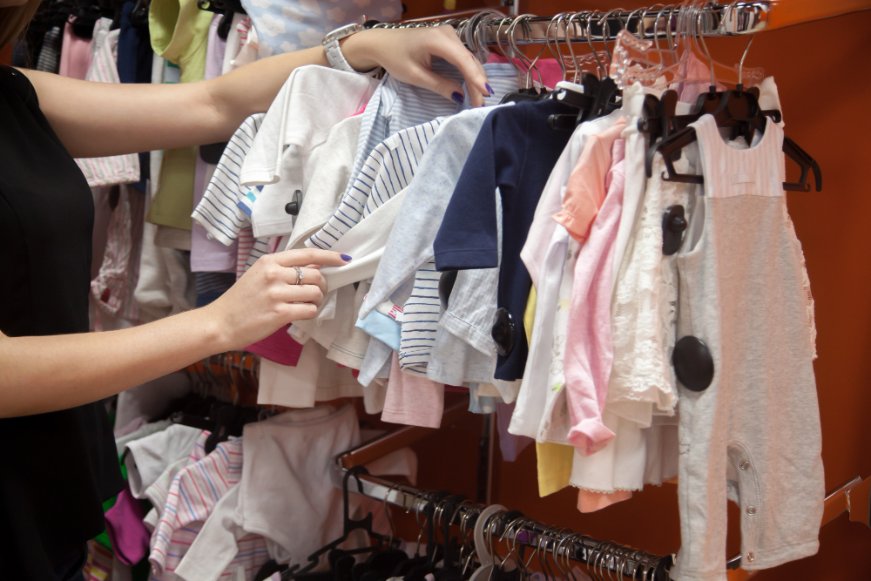
Seasonal Shopping Timeline
Timing purchases strategically can save families hundreds of dollars annually:
- January-February: Winter clearance sales, stock up on next year’s sizes
- August-September: Back-to-school sales extend to baby basics
- November: Black Friday deals on premium brands
- December: End-of-year clearances
Subscription Services and Rental Options
New sharing economy options help manage costs:
- Rental services: Companies like Tiny Closet offer designer baby clothes for special occasions
- Subscription boxes: Curated selections delivered monthly, sized appropriately for growth
- Hand-me-down networks: Organized clothing swaps in parenting communities
2025 Baby Clothing Trends
Technology Integration
Smart baby clothing represents the fastest-growing segment in 2025, with biosensor integration leading innovation:
- Temperature monitoring: Fabrics that change color to indicate overheating
- Sleep tracking: Integrated sensors monitor sleep patterns and breathing
- Growth indicators: Smart sizing that alerts parents when upgrades are needed
Sustainability Focus
Environmental consciousness drives purchasing decisions for millennial and Gen Z parents:
- Circular fashion models gaining 25% annually
- Regenerative farming practices in organic cotton production
- Biodegradable packaging becoming standard
- Carbon-neutral shipping options
Personalization Trends
Custom elements appeal to parents seeking unique pieces:
- Name embroidery and monogramming services
- Custom fabric prints featuring family photos
- Matching family outfit collections
- Birth announcement clothing with custom dates
Special Considerations
Premature Baby Clothing
Premature babies require specialized clothing considerations. Preemie clothing features unique design elements:
- Extra-soft seams to protect delicate skin
- Easy-access designs for medical equipment
- Temperature regulation fabrics
- Specialized sizing from 1-5 pounds
Sensitive Skin Solutions
For babies with eczema or sensitive skin, hypoallergenic clothing choices become essential:
- Bamboo and organic cotton exclusively
- Tagless designs to prevent irritation
- Flat-seam construction
- Chemical-free dyes and treatments
Climate-Specific Recommendations
Geographic location influences fabric and style choices:
- Hot climates: Lightweight cotton, breathable weaves, UV protection
- Cold climates: Layering systems, thermal underlayers, windproof outerwear
- Humid areas: Moisture-wicking fabrics, quick-dry materials
- Dry climates: Extra-soft fabrics to prevent skin dryness
Key Takeaways for Parents
- Prioritize comfort and safety: Choose soft, breathable fabrics like organic cotton or bamboo
- Buy strategically: Fewer newborn sizes, more 0-3 month pieces for better value
- Invest wisely: Premium brands for frequently used items, budget options for rapid growth periods
- Consider organic: GOTS-certified materials provide safety and environmental benefits
- Plan for growth: Babies outgrow clothing every 3-4 months in the first year
- Focus on functionality: Easy-change features and practical designs save time and stress
Conclusion
Selecting the best newborn clothing brands requires balancing quality, safety, budget, and personal values. Premium brands like Hanna Andersson and Little Sleepies offer exceptional durability and comfort for families willing to invest upfront, while budget-friendly options like Carter’s and H&M provide excellent value without compromising basic safety and comfort needs.
The global baby apparel market’s projected growth to $350.3 billion by 2033 reflects increasing parent awareness about quality and safety. Modern parents increasingly prioritize organic materials, sustainable production methods, and brands that align with their environmental values. This shift toward conscious consumption benefits both babies and the planet.
Remember that the “best” brand varies by individual needs, budget, and priorities. A newborn’s wardrobe should prioritize comfort, safety, and practicality over trends or appearance. Focus on building a foundation of quality basics from trusted brands, then supplement with budget pieces as needed for growth spurts.
Final Recommendations
For first-time parents: Start with Carter’s for reliable basics, add a few premium pieces from Hanna Andersson for special occasions, and choose organic options from Burt’s Bees Baby for sensitive skin protection.
For budget-conscious families: H&M’s organic line provides excellent value, while Carter’s multipacks offer the best cost-per-wear ratio for everyday essentials.
For environmentally conscious parents: Kate Quinn and Monica + Andy deliver premium organic options, while Burt’s Bees Baby offers accessible organic choices.
For luxury seekers: Hanna Andersson and Little Sleepies provide heirloom-quality pieces that maintain beauty and function through multiple children.
The key to building a successful newborn wardrobe lies in understanding your priorities, planning for rapid growth, and choosing brands that align with your family’s values and budget. Whether you choose premium organic cotton or budget-friendly basics, prioritizing comfort, safety, and practical features ensures your baby stays happy and healthy while looking adorable.
As you embark on this exciting journey of parenthood, remember that clothing is just one aspect of caring for your newborn. The love, attention, and care you provide matter far more than any brand name. Choose clothes that make daily care easier, keep your baby comfortable, and fit within your family’s budget – everything else is just bonus.

